Some of the links in this post may be affiliate links.
Few houseplants plants have caused such an uproar in the plant world as Pilea peperomioides. Commonly known as Chinese Money Plant, UFO Plant, Friendship Plant, Missionary Plant, Coin Plant or Pancake Plant…Pilea peperomioides care is easy if you can provide the ideal conditions that it prefers.
Keep reading so I can show you exactly how to care for this amazing plant, and I will also talk about propagation, as well as the most common Pilea peperomioides problems and how you can fix them.
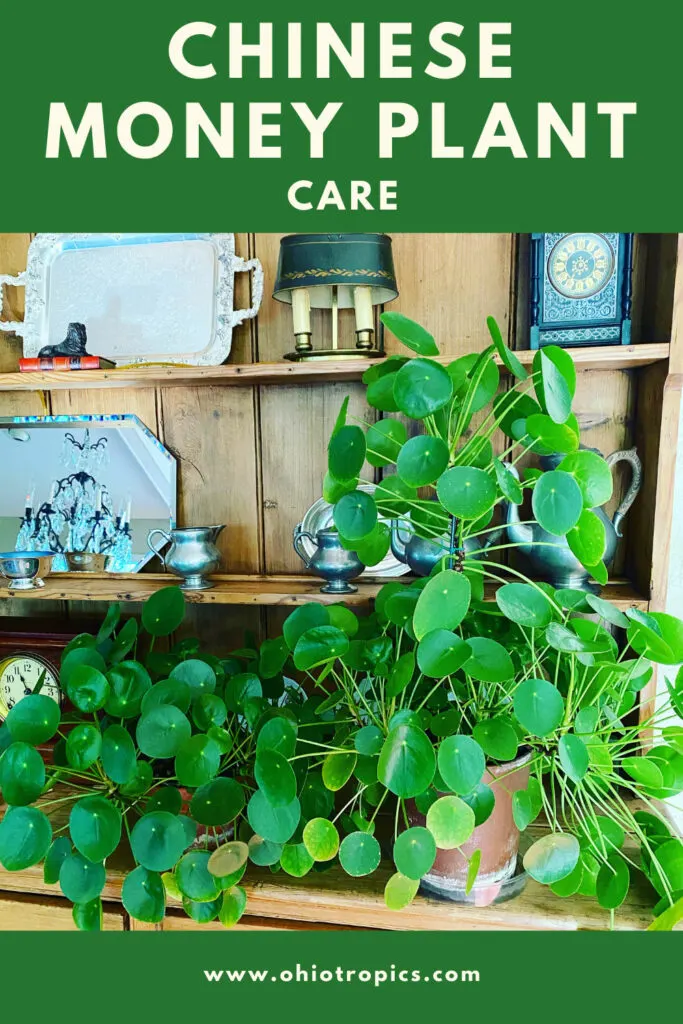
This species is only native to southern China in both the Yunnan and Sichuan provinces where it is reportedly rare in the wild, but is plentiful in cultivation.
It is a member of the stinging nettle family, and legend has it that Chinese Money Plant brings good fortune to its owner.
Now let’s get on to how to care for this plant.
Table of Contents
CHINESE MONEY PLANT CARE – 5 SECRETS
1. Light
Light is a hard issue in general to digest as far as growing plants go. It requires some experimentation, trial and error, and observation to see what works best for YOU!
Despite what you read on the internet on many sites, this plant can take some direct sun. I will tell you what has worked well in my experience.
Actually, I have corresponded with two people that have had their Pileas growing in full sun. I’m not advocating this necessarily, but it can work.
One thing that can happy though is that the color of your leaves will turn an overall yellow-ish green color in stronger light.
Plants grown in lower light will typically have leaves that are deeper green.
The general advice you’ll see on many sites is “bright indirect.” The dreaded bright indirect recommendation! Let me tell you what has worked for me.
I have two Pilea peperomioides plants and both are in different areas of light exposure. I have one that receives no direct sunlight at all, but it is just inches away from a very large Northern exposure window.
I would qualify this as “bright indirect light” because the room IS pretty bright, but it does not receive any direct sun. It is growing beautifully!
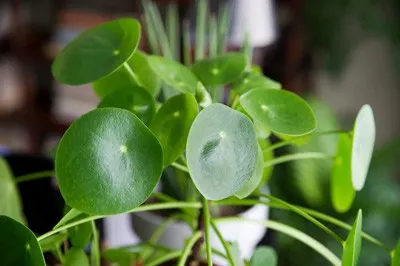
I have another Pilea peperomioides plant that is sitting on top of my piano right in front of a large Eastern exposure window. As a result of this, it does get some morning sun which is wonderful!
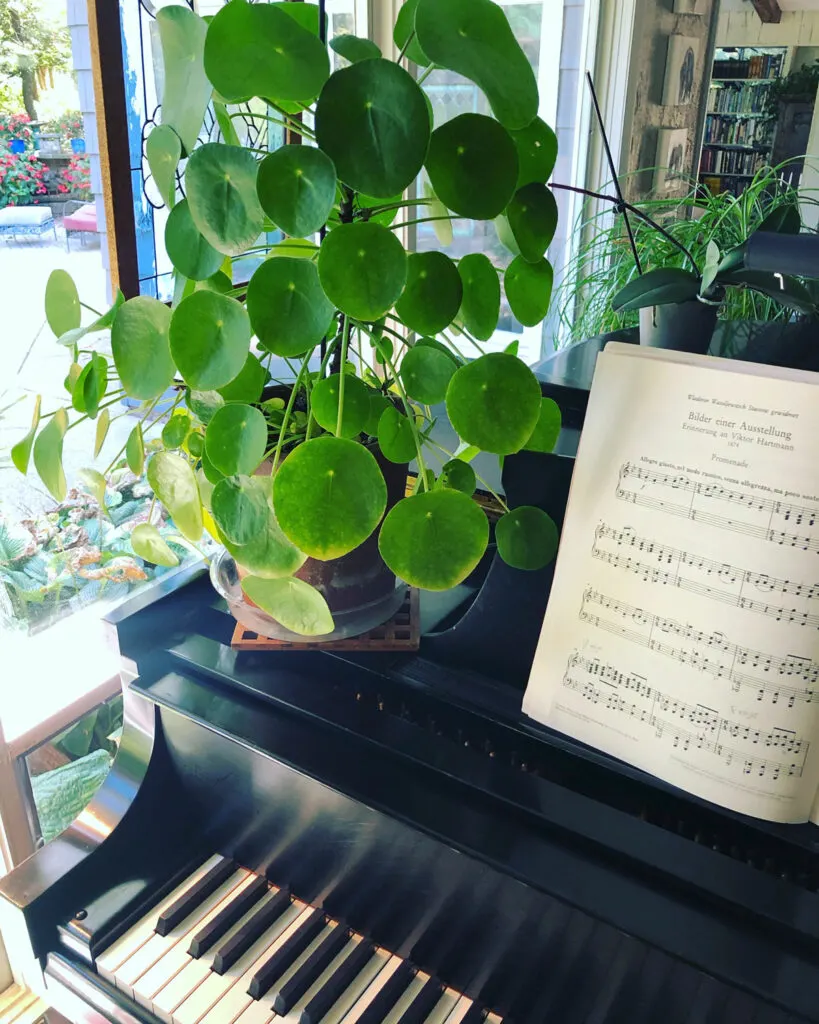
I found that this plant is growing faster and bigger than the one I have in the Northern exposure window. Both are perfectly acceptable locations!
Now, what should you avoid when it comes to light? I don’t care where you place this plant, but just don’t place it far away from a window. You will be disappointed and the plant will just not give you good growth if you don’t have it in a sufficiently bright spot.
This is not a low light plants and it needs to be right in front of a window for best results.
Under good light conditions, this plant is actually a pretty fast grower and you will get many more baby pilea plants being produced as well.
A few hours of sun, especially morning sun, are not only acceptable, but very beneficial in many cases!
Just keep in mind that the stronger the light is, the quicker your soil will dry out. So be aware of that! Chances are, your plant will dry out more quickly so you’ll have to be more vigilant with your watering.
If you do have a very sunny window, like a sunny Southern exposure window, you may need to place it a little further back (or use a sheer curtain to diffuse the sun). Just experiment and monitor your plant. If it looks good and is growing well, then you know it is happy!
One last comment for light is that you need to rotate your plant every so often so that it grows evenly. You will notice that plants will start to reach toward the window.
Simply turn the pot 180 degrees about once a week or so in order to keep your plant growing evenly.
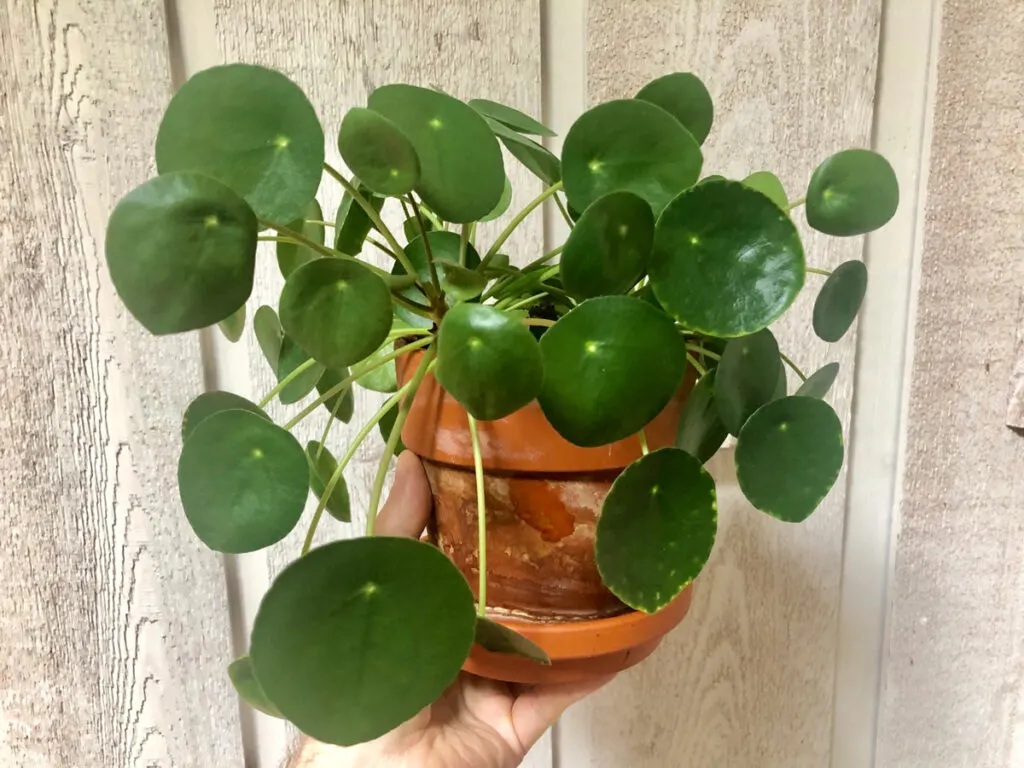
2. Potting Mix / Soil
This is an important section and I have a lot to say about potting mixes.
First off, these plants hate to stay wet for too long, so it is imperative that you provide the appropriate potting mix. The potting mix should be very well drained and porous. Allow me to recommend some potting mixes that work well. I purchase everything I need most of the time on Amazon to keep it simple.
Hoffman Cactus & Succulent potting mix works very well. Just because it is labeled a cactus and succulent mix, doesn’t mean that you can only use it for cacti and succulents.
Another blend that I like using is Miracle Gro Cactus Palm & Citrus potting mix. Both blends work wonderfully.
I use these blends for most of my succulents and also for some other plants such as all my Pilea and Peperomia species, and other plants that require good drainage and the need to dry out quickly.
To these blends though, I do like to add some important ingredients in order to improve them. I rarely use a packaged potting mix as-is.
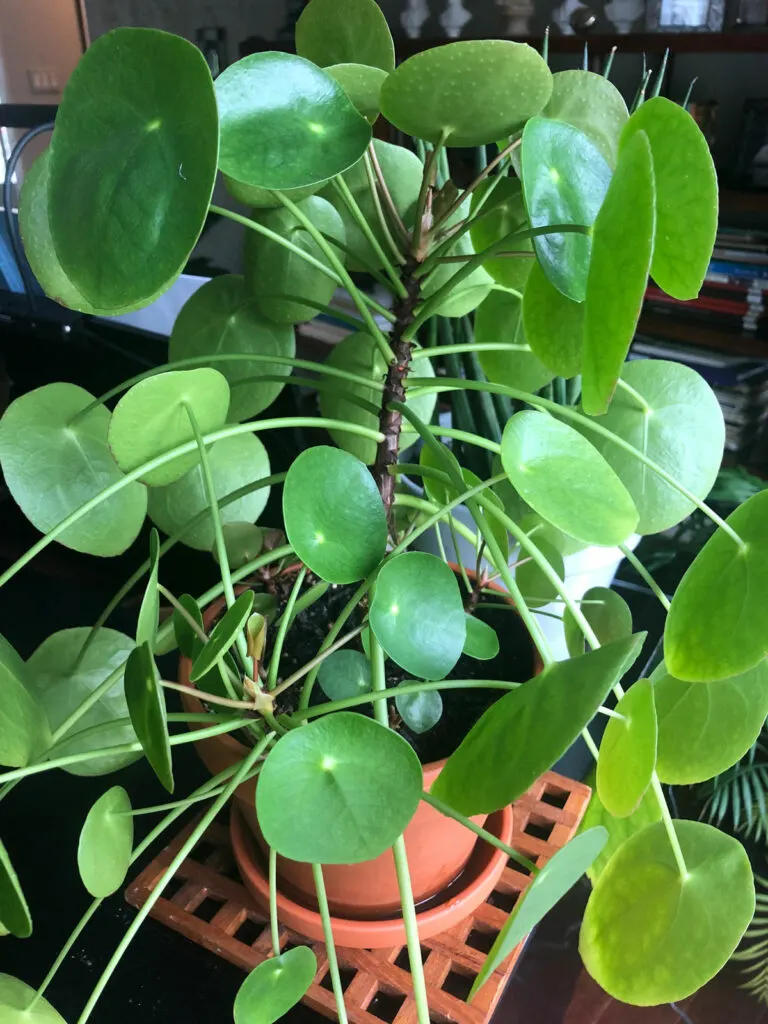
Sometimes if I run out of a premixed cactus/succulent potting mix, I will use any good houseplant potting soil that I have on hand.
You can easily amend your “normal” houseplant potting mix to make it more suitable for Pilea peperomioides:
Coarse sand is wonderful to add to a standard houseplant potting soil and make it instantly suitable for succulents and plants like Pilea. You can’t use any old sand though! Definitely not beach sand or finer sand because this can cause the soil to compact too much.
Pumice is a wonderful soil additive and really works well to create the aeration and porosity that many plants love. It is a great potting mix amendment for cactus, succulents, and Pilea and others.
Perlite accomplishes the same as pumice, but since it is much lighter, it will sometimes float to the top when you water.
Depending on what I have on hand, I will vary what I add to my potting mix. I typically use about 2 parts of the potting mixes mentioned above plus 1 part of pumice.
The end goal for Pilea peperomioides is a potting mix that drains quickly and also dries out pretty quickly. So experiment with your potting mixes and see what works best for you.
They do prefer slightly moist soil, but I allow the top inch or two to dry out before I water again.
If you’re looking for an amazing potting mix that you can use straight out of the bag for your Pilea, check out the Tropical Succulent soil blend from Oh Happy Plants. This is an amazing mix and you will get 10% off at checkout automatically if you use my link.
3. Pots
This is really a matter of preference. You can successfully grow Pilea peperomioides in a variety of different types of pots, as long as the pot is appropriately size and not too large.
If you have a pot that is too large, the potting mix may take too long to dry out and cause you problems! Especially if you also use a poor quality potting mix.
Whenever you repot your plants, a rule of thumb is only to repot into the next 1 or 2 sizes up from where you currently are.
For example, if you are using a 4 inch pot and need to repot, only move up to either a 5 or 6 inch pot. No bigger!
And be careful of pots that are unusually deep. These can be problematic in terms of the soil drying out quickly enough.
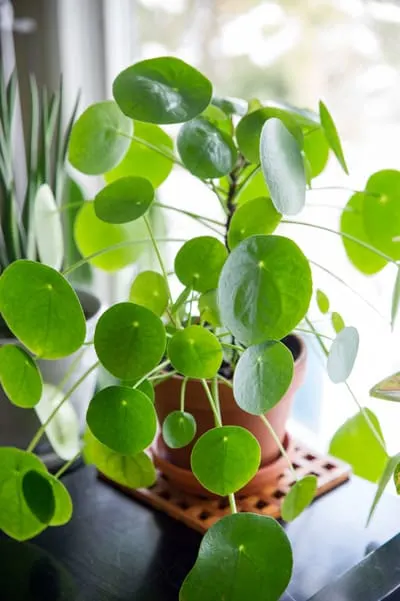
As far as pot construction, I really like terra cotta pots! They allow the potting mix to dry out sooner. Of course, this means that (depending on your watering habits and potting mix), the soil might dry out TOO quickly!
It all depends on your watering habits. I really believe that these plants grow better in terra cotta pots.
And you will need a lot of pots! These plants are very prolific and will produce many new plantlets that you can share with family and friends!
I wrote a very informative blog post on terra cotta pots so be sure not to miss that after you finish reading this post. I talk about the pros and cons, and many other tips that you may not have heard of anywhere else.
Other types of pots would work well too. Whether you choose plastic pots, glazed ceramic pots, or anything else, the important part is that the pots have drainage holes. Absolutely by no means should you plant directly into a pot with no drainage hole.
However, it is OK to plant in a plastic pot with drainage holes and then slip it into a decorative pot with no drainage hole. Just slip the plant out to water it, and then return it back into the decorative pot.
The plant should never sit in standing water or it will suffer root rot…and BYE BYE PILEA PEPEROMIOIDES!
Again it’s all personal preference as far as pot type so experiment and see what works best for you!
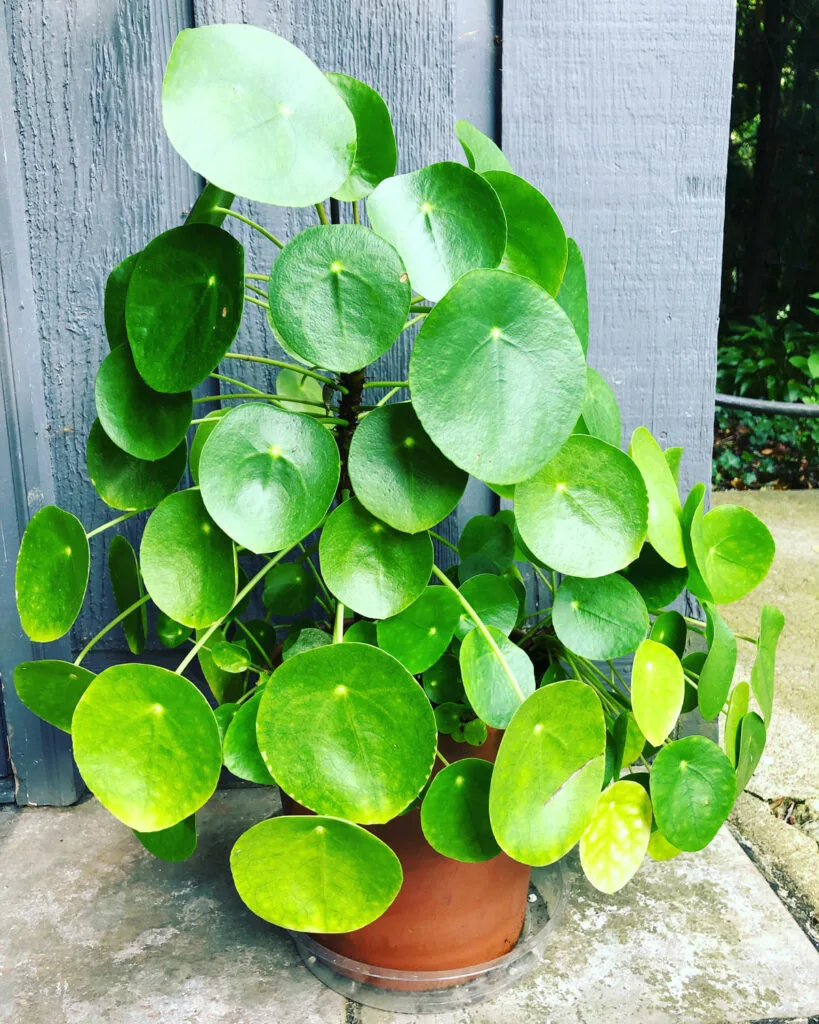
4. Water & Fertilizer
Those of you that follow me closely on Instagram (@ohiotropics) know my philosophy on watering. Water thoroughly until water comes out of the drainage hole. Don’t stop adding water until this happens.
Let it all drain out, and then return it to its window.
I like to take my Pilea peperomioides straight to the sink and I water them there. I circle the watering can or faucet attachment all around the pot to ensure that ALL the soil will be moistened. Let ALL the excess water drain away.
As a rule of thumb, I always wait until at least the surface of the soil is completely dry before I water this plant again.
Don’t even think about watering if the surface of the potting mix is still moist.
ON THE OTHER HAND! You want to try and avoid letting your soil dry out completely, especially for long periods of time. These plants will quickly develop yellow and brown leaves (starting at the base and working their way up) if you do this.
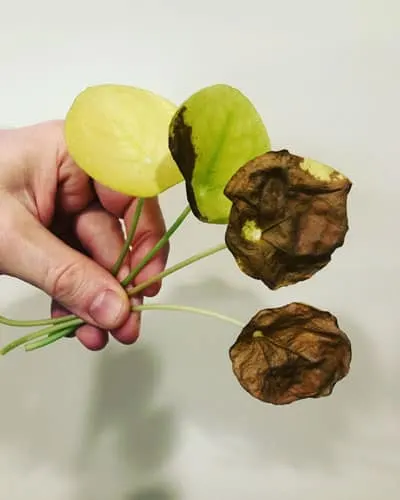
I’d recommend not using a watering schedule, and instead, go ahead and feel the potting mix with your fingers to determine when to water.
Please also avoid soil moisture meters as they are notorious unreliable!
As far as fertilizing goes, I like to fertilize all my houseplants pretty much year-round except for the dead of winter when almost nothing is growing.
I like to use Dyna-Gro Grow fertilizer for most of my houseplants including Pileas. There are instructions on the label on how to dilute it so that you can use it every time you water your houseplants.
This is how I prefer to fertilize because I can do it every time and not have the remember the last time I fertilized.
Dyna-Gro Grow is an AMAZING all-purpose plant fertilizer. It costs a little more than typical fertilizers, but it is a COMPLETE fertilizer that has all the macro and micronutrients that plants need and is urea-free.
I switched to this fertilizer for almost all of my houseplants and the results are amazing.
So check it out for yourself! You will be pleasantly surprised at the results. Remember though that proper plant conditions come FIRST.
Fertilizer will only enhance your results. You will not fix a plant that has had poor care (poor light, poor drainage, etc.) with fertilizer.
5. Propagation
One of the best parts of growing this plant is that it is super prolific in producing babies.
All you need is one of these plants and your home will soon be overrun with new plants in every room! Or you can share and give them to friends.
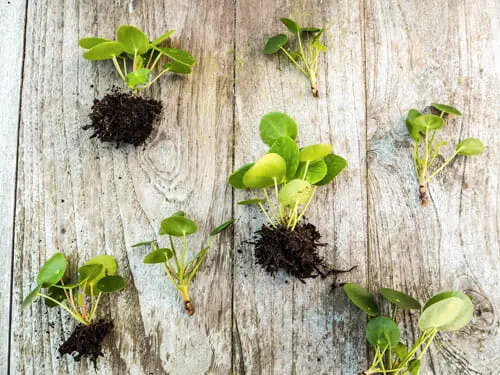
And there is nothing wrong with NOT separating the babies. You can leave them all in the same pot and this will just result in a very full plant.
I will show you an example of that shortly with one of my plants.
Some people like that look and it is certainly OK to do so! But you can easily separate the babies and pot them up into small pots and share with friends! Let’s go over how to do this.
This is one of the easiest plants to propagate because perfect little plants will grow right out of the potting mix at the base of the plant.
Once they have at least 3 or 4 small leaves, you can simply separate them.
Be sure to get at least part of the stem that is under the soil. If you can do this without taking the plant out of its pot, go ahead and do so.
If not, it is OK to take the plant out of its pot so that you can easily separate the babies. You can use your fingers, scissors or a sharp, clean knife to sever the small plants.
If you were able to get some roots on the pups, simply pot them up. If not, you can simply take the little pups that you separated, and place each one in a small glass or vase of water and allow it to root.
Just make sure that the water level submerges just the roots and not the whole plant.
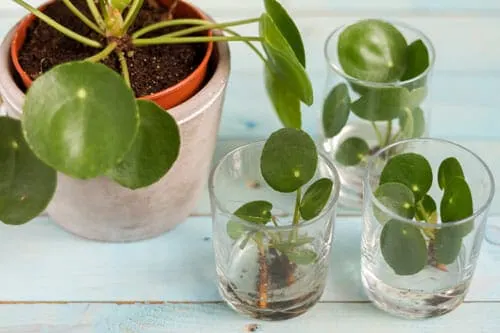
After it has developed a few roots, you can pot it up! I would suggest 2-3 inch pots for the babies and wait until they are big enough before transplanting into a larger pot.
In one case, I actually chopped off the main growing stem of my plant and placed it in water. If your Pilea is getting to leggy, this is a good solution! Just cut it off and place it in water!
I rooted the plant below easily in water and then potted it up.
It took about 2-3 months or so before the cutting rooted and was able to be potted up.
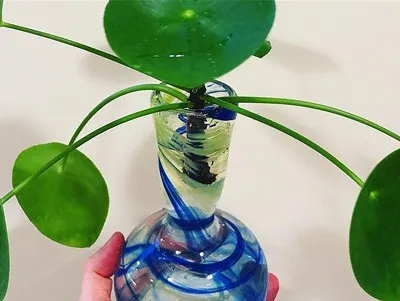
Here is the rooted cutting:
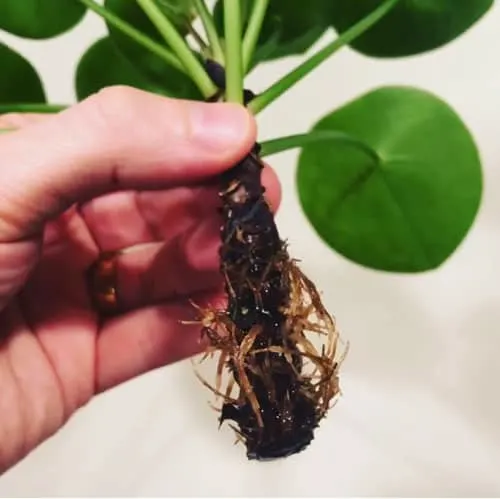
And this is how it looked like after I potted it up and grew for a few weeks. I ended up giving this plant to a friend.
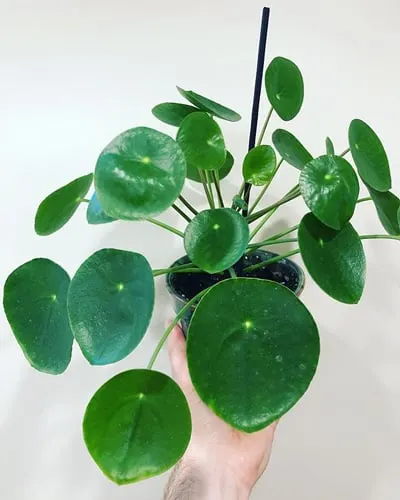
This is what the original plant looked like when I chopped off the main stem.

The original pot on the left had a few pups. Now…fast forward 5 months after I cut off the main growing stem, and this is what the original mother plant looks like:
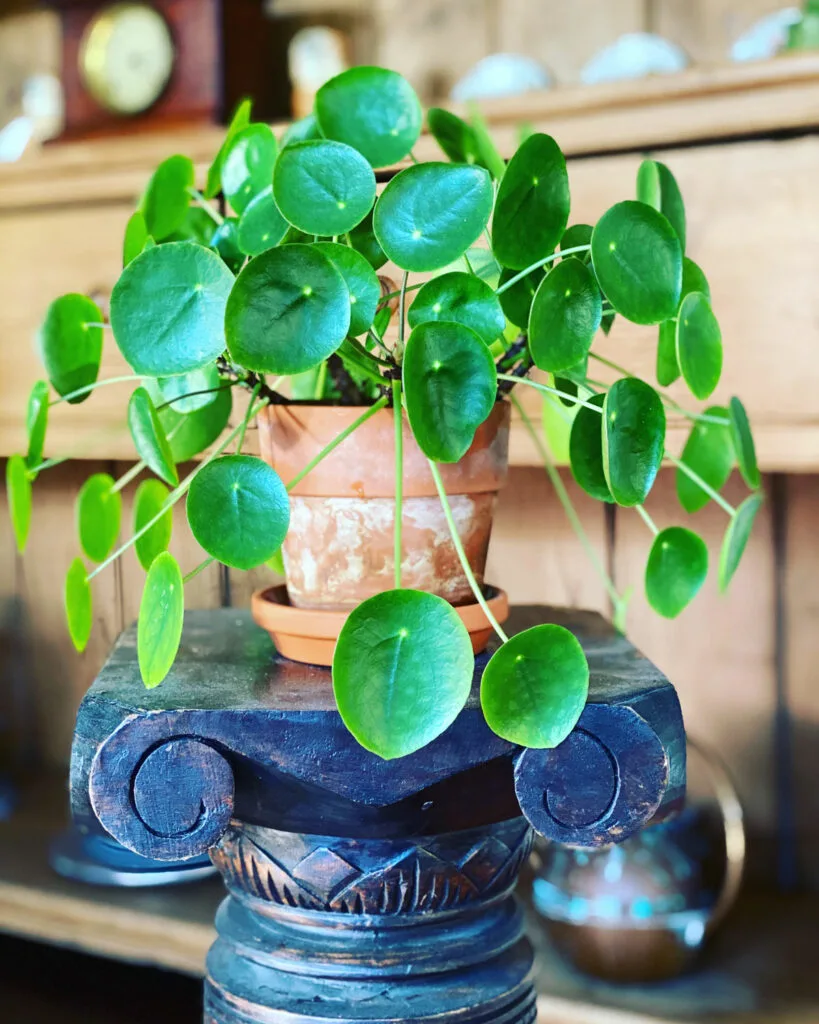
In addition to all the pups filling out and growing beautifully, it also has 9 new pups forming. You can’t see all of them in the photo below, but you get the point!

If you would like to watch my YouTube video on how to propagate Pilea peperomioides, check it out below!
Lastly, if you’d like to explore Pilea peperomioides propagation in more detail, including an unexpected way to propagate this plant that was not covered in this post, visit my Pilea Peperomioides Propagation post.
And did you know that you can actually propagate Pilea peperomioides from a single leaf?
I also have a post that breaks down 10 ways to encourage pilea pups to grow.
Pilea Peperomioides Problems & Common Questions
I’ve included a special question and answer guide below detailing common Pilea peperomioides problem that people have with these plants.
This IS an easy plant to grow, but if you don’t know what it likes, it can give you some problems. Take a look at some of the main problems that people have had with this plant, as well as my recommended solutions.
Why is my plant not growing? I’ve had it a while and there has been no new growth!
You are probably not giving it enough light! Plants need light to photosynthesize so that they can make their own food in order to grow.You can’t expect a plant to grow well if you shove it in a dark corner of your home, or if it is very far away from a window.
I’ve heard that these plants produce a lot of babies. Why is mine not growing any babies???
Nature teaches us patience. Just give it some time! If your plant appears healthy and is growing well and receiving proper light, it is just a matter of time before it grows little baby plants.Depending on how old your plant is, it may be at least a few months before you see babies start to appear.
Why are my leaves curling?
There can be a variety of reasons why this happens, but one reason that this will happen is if your potting media is not drying out quickly enough.
Once, I repotted one of my Pilea peperomioides into a pot that I knew was MUCH too big, but I didn’t have anything smaller and was too lazy to go get an appropriately sized pot.
Needless to say, the potting mix was not drying out and the newer leaves were curled.
I immediately corrected the issue and replanted it into a smaller pot, and it resolved the issue. Of course I knew better but I was being lazy (which ends up creating more work later.)
If you have a potting mix that is not well drained, this can also be an issue.
Be sure to follow the recommendations on soil blends found earlier in this post.
Why are there white spots symmetrically scattered on the leaves?
Pilea peperomioides have pores on the undersides of the leaves and sometimes the plant will release excess minerals (from tap water or fertilizer) through these pores. It will almost look like little grains of salt.
It does not harm the plant, and you can simply brush them off gently with your finger. If you switch to purified or distilled water, this issue will be eliminated. Again, it will not harm the plant.
My plant is drying up so quickly! Much more quickly than it used to. Am I doing something wrong?
Your plant may need to be repotted into a larger pot. This happened to me as well with one of my plants. It seemed to dry out twice as quickly as it used to, but nothing else changed (light, season, etc.) It turned out that it was very potbound, so repotting it into a larger pot did the trick.
I got a yellow leaf! What am I doing wrong! Am I killing my plant?
I get this complaint a lot from so many people freaking out over one or two leaves yellowing. There is no reason to worry if the leaves were older leaves from the base of the plant.
This is a natural cycle of nature! Eventually the older leaves will turn yellow. It doesn’t necessarily signal that you are doing something wrong.
However, if you are getting a lot of yellow leaves, at the base of the plant, immediately check your soil. This can happen if you let your soil dry out completely for a while.
If this has happened, immediately water your plant!
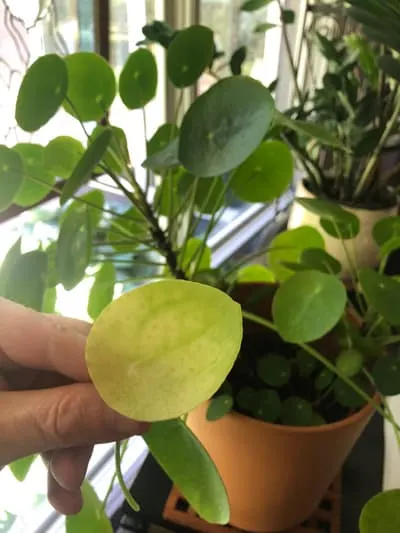
Why are all my leaves yellowing?
There are various reasons why this can occur. If more leaves that just one or two at the base are yellowing, it could be the sign of a more serious problem.
“Overwatering “is one reason that you can get many yellow leaves.
The potting mix needs to dry out in between watering. I actually despise the word overwatering. It is a very deceiving word and has caused a lot of misunderstanding in plant care.
I highly recommend reading my blog post on watering myths. It will really help you a lot because the term “overwatering” is VERY misunderstood!
Also, if you let your plant sit in a saucer of water for extended periods of time, this is very problematic.
Another reason for yellowing leaves can be lack of nutrients. Do you fertilize? Learning how to fertilize is a very important aspect of being a plant parent.
If you have gone way too long without fertilizing, this can also be an issue, especially if the plant has been in the same pot for a very long time.
Finally, Pileas peperomioides that are in too much direct sun may also turn a yellow-ish green color. Simply move it to an area with less direct sun and it may correct the problem.
My whole plant is drooping! What happened?
When I get too busy with life and don’t pay attention to my plants, this can happen. It can simply mean that your plant has completely dried out and is starting to wilt from stress.
Check the soil with your finger. Does it feel bone dry? Lift the plant up with your hands. Does it feel lighter than normal? Chances are you just need to give it a good drink of water.
When your potting mix gets bone dry, you may need to drench the soil a few times in order to ensure that you are thoroughly moistening the soil.
When this happens, the water will seem to go straight through and not moisten the soil much. Sometimes potting mixes that have gone too dry (especially peat-based mixes), will be difficult to re-wet so water it a few times in a row until the soil is thoroughly moistened.
Or maybe your plant is drooping and you find that the potting mix is still moist. You may have kept your plant wet for too long and may have started to have root rot.
Why do my leaves have long petioles?
These plants have naturally long petioles (the petiole is the long “stem” that is attached to each leaf.) If you find that the petioles are getting longer and longer, it’s probably due to your plant not getting enough light.
Increase your light levels by moving your plant to a brighter location, and the new growth should be more compact.
Does Pilea peperomioides bloom?
Yes it does! It’s not super common for them to bloom indoors, but they do indeed bloom. The inflorescence has tiny white flowers.
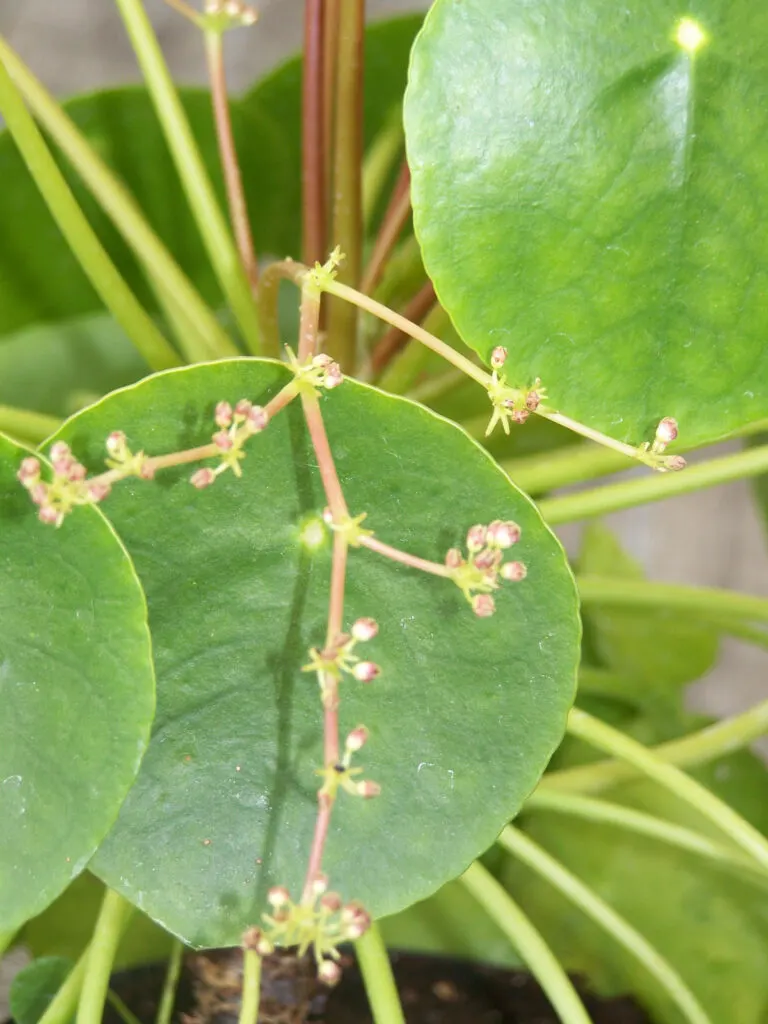
What are all the bugs flying around my P. peperomioides?
They are likely fungus gnats which will thrive in potting mix that stays continually wet. Check out my blog post on how to eliminate fungus gnats.
It is not as simple as just placing some yellow sticky traps around your plants, so don’t miss my post if you have been struggling with fungus gnats.
HOW TO GROW BIG PILEA PEPEROMIOIDES
This is one of the main questions that I get from many people. “How do you grow your Pilea peperomioides so big???”
Pilea peperomiodes can actually get pretty tall. Check out the photo below of my plants.
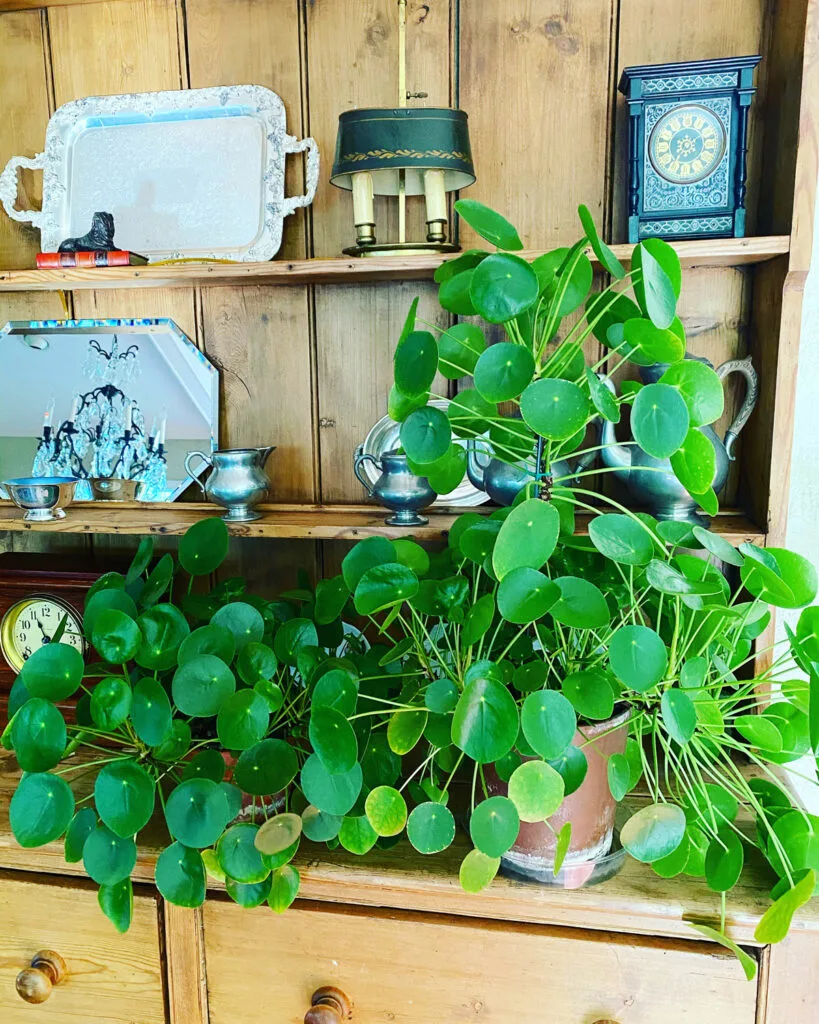
The plant on the right is actually about 21 inches tall (from the soil level). If I’m counting the pot, it is 2 feet and 4 inches tall!
How do you get this plant to grow so big? There are no shortcuts. It is the result of consistent, unwavering care.
If you follow all the light, soil, and fertilizing recommendations in this post, you can have a big Pilea too!
The most critical aspect (aside from LIGHT of course), is special attention to the soil moisture. You want a happy medium. Completely dry soil will cause your plant’s lower leaves to yellow and then it’ll be pretty bare.
On the other hand, you don’t want to keep it wet. You still want to allow the surface of your soil to dry out. Aim for 1 inch of the soil to dry out before watering. You will NOT be “overwatering” if you do this. If you can strike a good balance, you will achieve great results!
That’s it folks! Phew! That was a lot of information. Hopefully this helps you care for your Pilea peperomioides better. Do you have a Pilea peperomioides? Do you have any more tips to share other than what you read in this post?
If you are obsessed with Pileas, there are many different kinds! You might like to grow Pilea glauca as well with its beautiful cascade of silvery leaves!
Comment below! I’d love to hear from you.

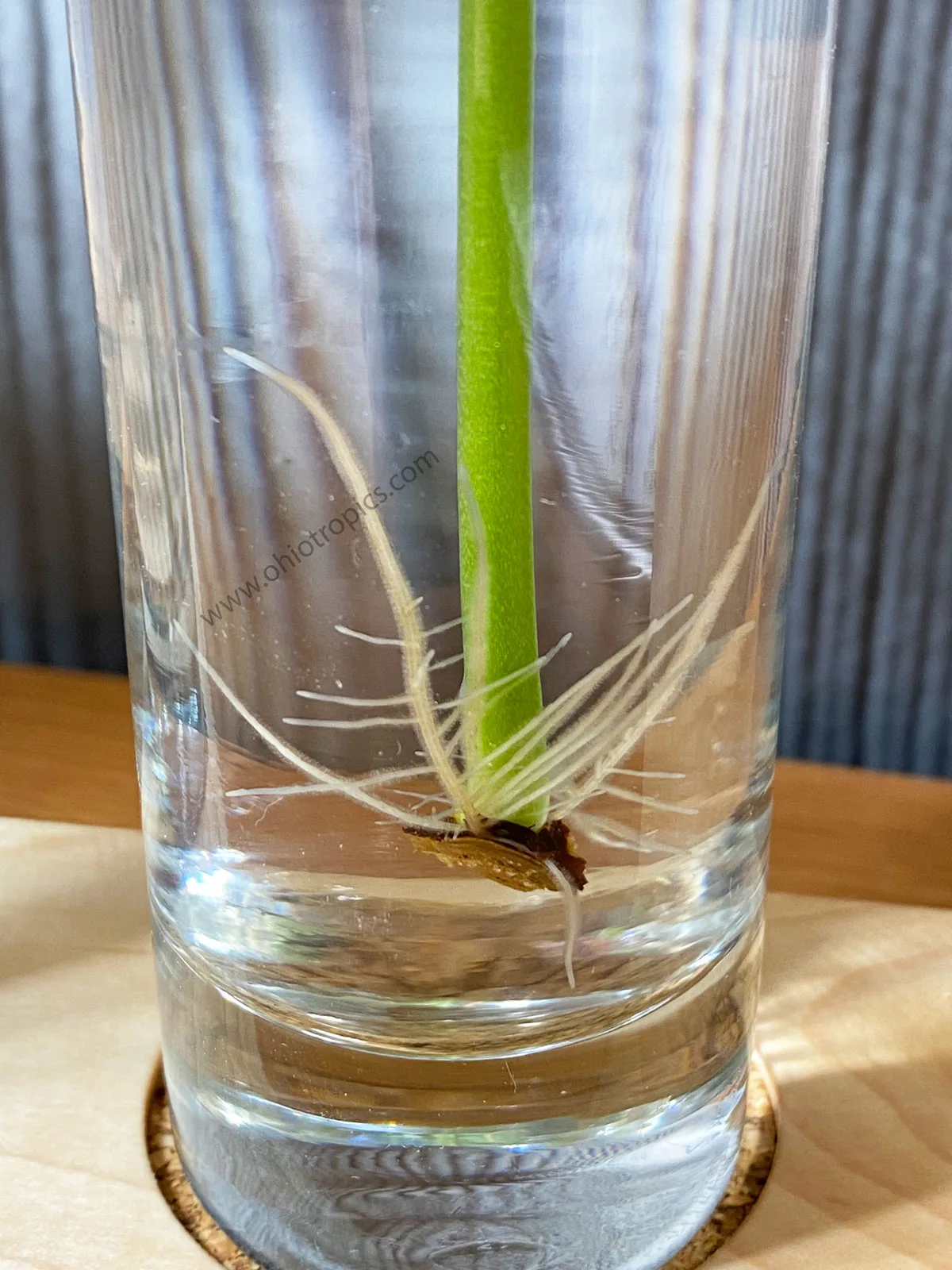
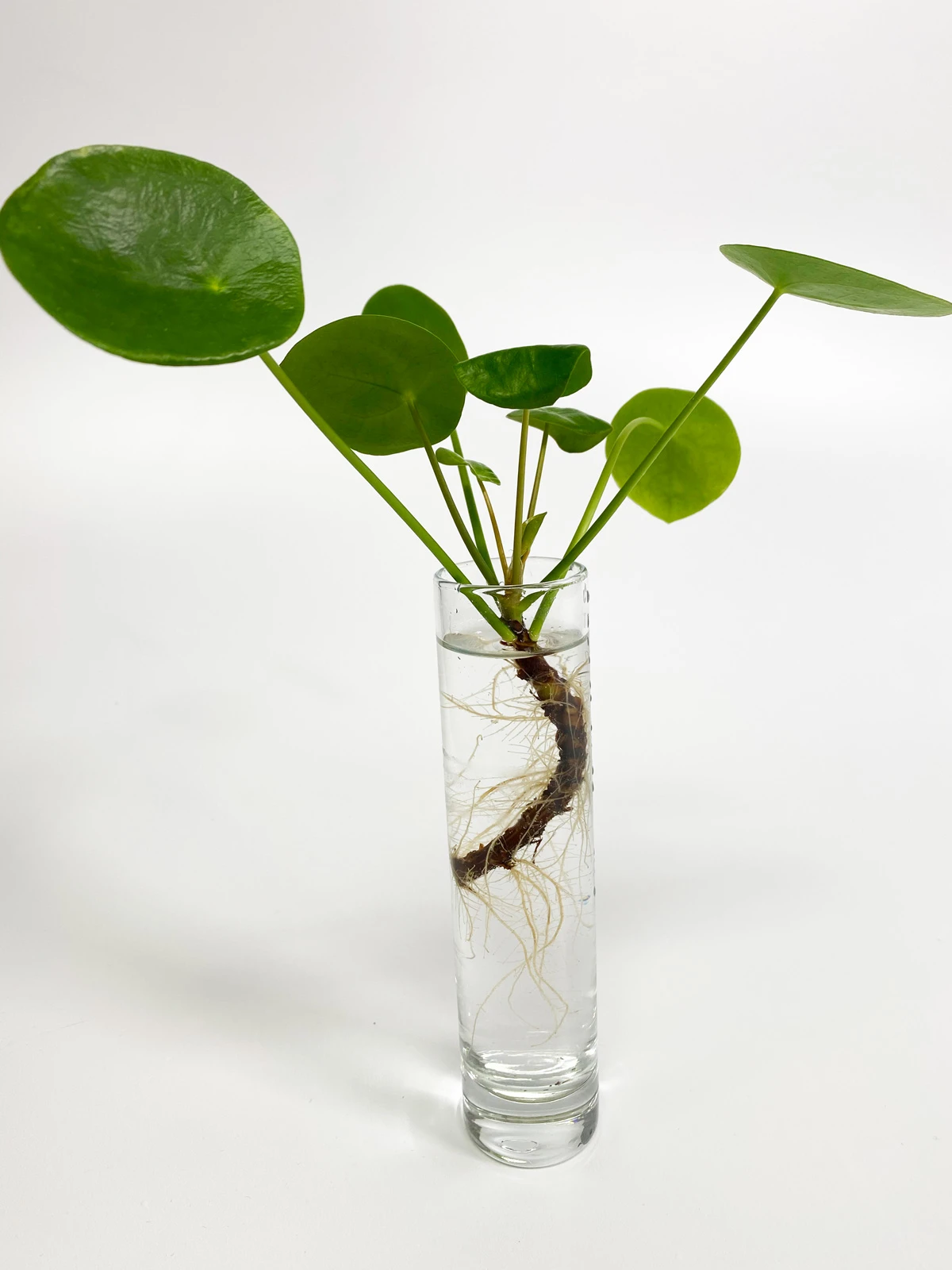
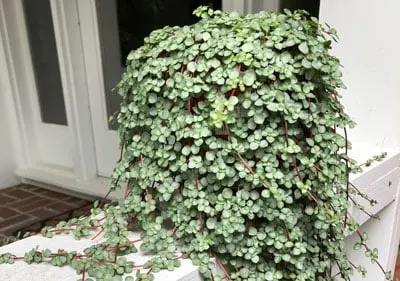

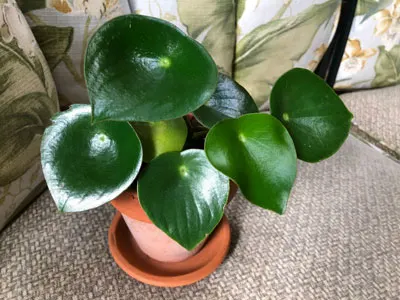
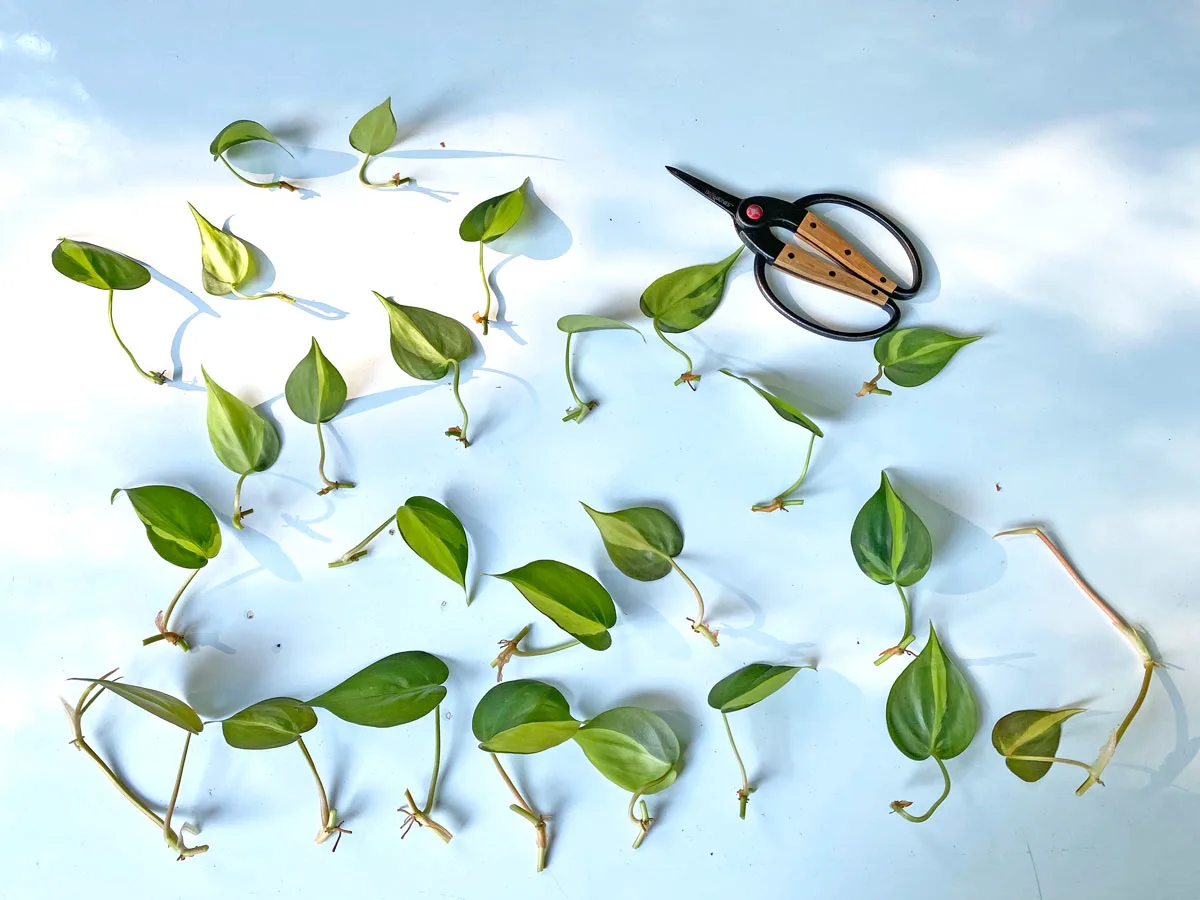
Kate Willet
Thursday 25th of July 2024
oops, actually I have had the pilea close to three years - and never used any fertilizer. Perhaps this was issue?
Raffaele Di Lallo
Thursday 25th of July 2024
I find that these plants need regular fertilizer. They will green up nicely! I also like to put mine outside. The rain does wonders, and while outside, a couple of applications of miracle gro fertilizer will work wonders to green up your plant and encourage more growth. I hope this helps a bit!
Kate Willet
Thursday 25th of July 2024
My pilea that I've had about two years which started with gorgeous long arching stems and happy coins sprouting out to create that sort of rounded top canopy never stayed that way. I keep a spreadsheet and like to water it every seven days especially since it's in a bright window, which doesn't get direct sun, and was in a terracotta pot. But the leaves are rarely deep green and glossy. They're often tinged with yellow while the stems don't grow that long arch that is reminiscent to me of those crazy floor lamps with the thin stems and the light bulbs on the ends. Anyway, today I decided to do the transplant, tired of the shorter stems and the non glossy leaves, and put it in fresh mix - I am using miracle grow, the formula for that is meant to address problems with overwatering/and underwatering. I was thrilled finding an already completely seperate pup cluster with its own root system, which I potted separately today. As for the main plant that was in a the 4.5" wide and about 5-6" high natural terracotta pot, it seemed like that might have been too deep since the roots didn't seem to grow as far into that lower soil as expected. So I put it into a wider-mouthed and lower ceramic bowl, one for retaining moisture a little better, and hope that helps the issue. What I'm looking for is a taller lusher plant like you show with the graceful arched stems. The main plant also has almost subdivided into another second root system with larger pups, and I could've separate and replanted that one, however worried about creating excess stress on the plant. I do often blend some perlite with my Miracle Gro and forgot..however I think the bits of orchid bark should assist w/ the drainage. Yes of course there is also a drainage hole. Will this transplant help achieve the goals? The one issue I think which set me back is it wanted wider and shallow growing room, not taller and deep, even though I had it in a standard medium terracotta plant, not oversized for its root growth. Thanks!
Diana
Tuesday 7th of March 2023
Hi! I have a question! My Chinese Money plant has developed a very long growth which seems to be attached to the plant. It does not look like the flowers I have seen in photos of this plant. Could it be a rogue weed that has found it’s way into my plant? Really strange. I wish l could send you a picture. Thanks!
Raffaele
Tuesday 7th of March 2023
Hi Diana! I'd have to see a photo to be sure. I'll send you an email now and you can attach the photo.
Maria Luisa
Monday 30th of January 2023
Hello. How long does a pilea live in a suitable substrate with lighting and humidity. How often should I change to a new substrate? It is advisable to have the pileas in water and how they are fertilized in water (dose, frequency, etc). I appreciate your help.
Maria Luisa
Thursday 9th of February 2023
@Good morning. Thank you so much. I have 2 pilea plants. I would like to send you pictures of them. Both plants have umbrella-shaped leaves. They are near a window, 30 cm approx. From one of them I have transplanted 3 babies and they also have their leaves in the shape of umbrellas. These babies are further away from the window. I transplanted them a month after buying them. The substrate that I use has 2 parts of universal soil, one part of perlite, 1 part of coconut fiber and a tenth part of worm humus. I water them when the surface is dry about half a finger on my hand. I would like to know what I am doing wrong with them and how I can correct so that the leaves do not continue in the shape of an umbrella. The smaller leaves on the baby plants have now changed to dark brown colors, they are the leaflets at the tip of the plant. Hopefully I can send photos. Thank you very much for reading me. Greetings.
Raffaele
Thursday 2nd of February 2023
Hi Maria. They can live indefinitely, especially if you keep propagating. I don't change any substrate until it's time to repot, whenever it is root bound. You can grow them in water if you'd like. Use a good fertilizer like Dyna-gro Grow and they have the recommended dilution for hydroponic growing right on the label. I hope this helps a bit.
Jane Hayes
Wednesday 2nd of November 2022
Loved the photos of your plants and home,especially by the piano. My plant is green but the leaf and stem fall off !!! I will repot to a smaller size. I got this plant in the summer,and it grew so well in the original tiny pot...that may be the problem. thank you
Raffaele
Wednesday 2nd of November 2022
Glad you enjoyed the article Jane! Good luck!